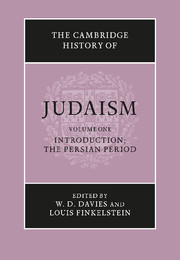Book contents
- Frontmatter
- INTRODUCTION
- THE PERSIAN PERIOD
- 4 The Persian empire and the political and social history of Palestine in the Persian period
- 5 The archeology of Persian palestine
- 6 Hebrew and Aramaic in the Persian period
- 7 The Jewish community in Palestine in the Persian period
- 8 Prophecy and Psalms in the Persian period
- 9 Wisdom literature in the Persian period
- 10 Jewish religious life in the Persian period
- 11 Persian religion in the Achemenid age
- 12 Iranian influence on Judaism: first century B.C.E. to second century C.E.
- 13 The Diaspora
- Bibliographies
- Chronological Table
- Index
- References
4 - The Persian empire and the political and social history of Palestine in the Persian period
from THE PERSIAN PERIOD
Published online by Cambridge University Press: 28 March 2008
- Frontmatter
- INTRODUCTION
- THE PERSIAN PERIOD
- 4 The Persian empire and the political and social history of Palestine in the Persian period
- 5 The archeology of Persian palestine
- 6 Hebrew and Aramaic in the Persian period
- 7 The Jewish community in Palestine in the Persian period
- 8 Prophecy and Psalms in the Persian period
- 9 Wisdom literature in the Persian period
- 10 Jewish religious life in the Persian period
- 11 Persian religion in the Achemenid age
- 12 Iranian influence on Judaism: first century B.C.E. to second century C.E.
- 13 The Diaspora
- Bibliographies
- Chronological Table
- Index
- References
Summary
OUTLINE OF HISTORY
When in 539 b.c.e. Babylon fell to Cyrus, the Achemenid king of Persia (559–530 b.c.e.), Persia was raised to the position of a world empire, which encompassed the whole Near East. In contrast to the Assyrians and Babylonians, however, who had based their rule on large-scale deportations of peoples and a reign of fear, Cyrus from the outset adopted a much more lenient policy, which included resettling exiles in their homelands, reconstructing their temples, and in general presenting himself to the conquered as a liberator. This policy gained him the goodwill of almost the entire ancient world.
Within the framework of this policy, Cyrus issued a proclamation to the Jewish exiles in Babylon, urging them to return to Jerusalem and rebuild their Temple there. The first Jews to return from Babylon, headed by Sheshbazzar ‘the prince ofJudah’ (apparently Shenazzar, the son of Jehoiachin, the former king of Judah), encountered numerous difficulties in their attempt to re-establish the national and religious centre of the Jewish people. On their arrival, they found on the outskirts of the destroyed city a small community of the Am ha-Ares, the descendants of the poor, who after the destruction of the first Temple, had continued to dwell in the almost desolate land. This remnant and their neighbours, the Samaritans, Ashdodites, Edomites and Arabs, did not view the repatriates with favour, and used all means in their power to obstruct them, until they finally succeeded in putting an end to the building activities in Jerusalem.
- Type
- Chapter
- Information
- The Cambridge History of Judaism , pp. 70 - 87Publisher: Cambridge University PressPrint publication year: 1984
References
- 3
- Cited by

